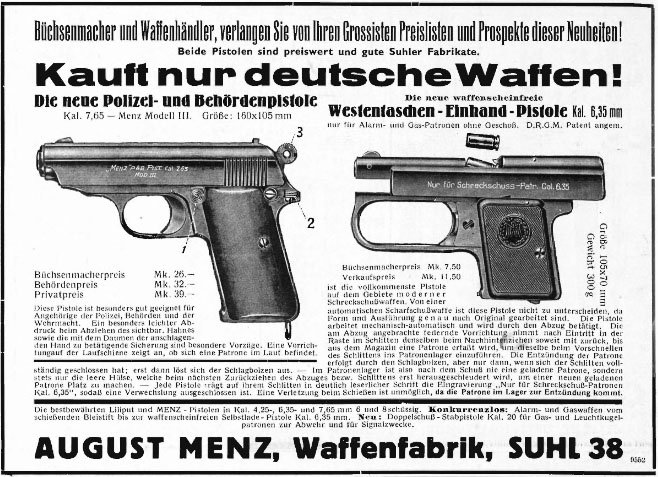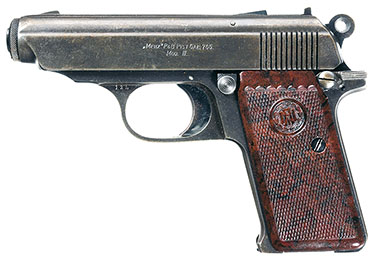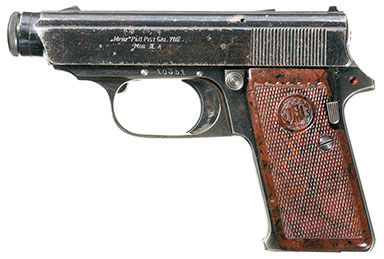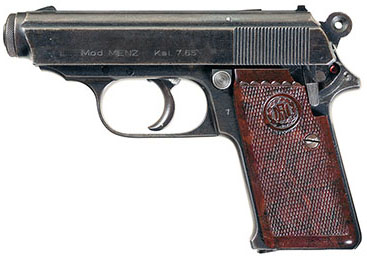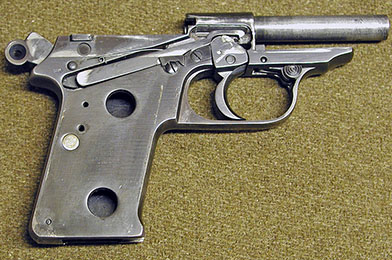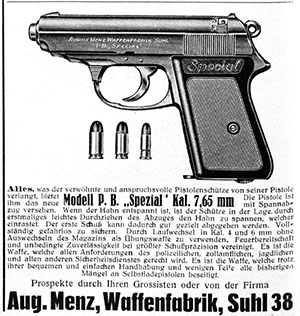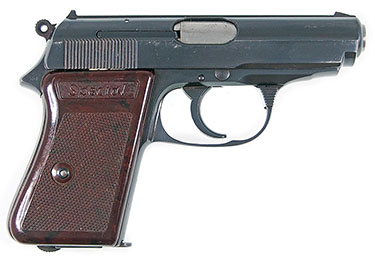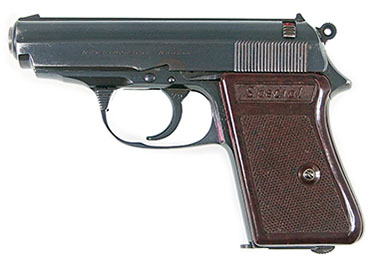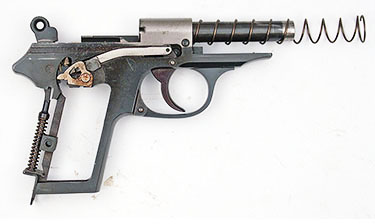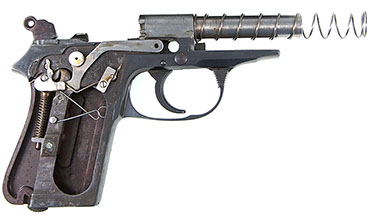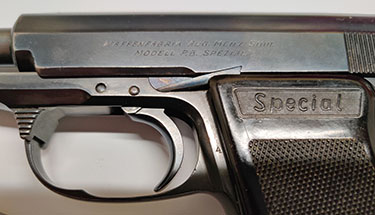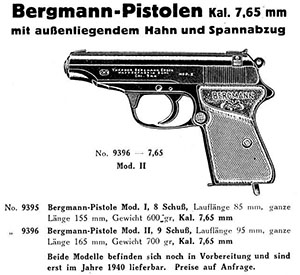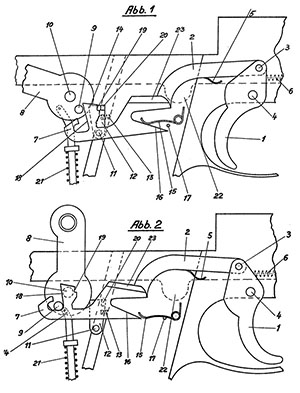 |
||||||||||||||||||||||||||||||||||||||||||||||||||||||||||||||||||||||||||||||||||||||||||||||||||||||||||||||||||||||||||||||||||||||||||||||||||||||||||||||||||||||||||||||||||||
|
The Menz PB Spezial Pistol by Ed Buffaloe
On 12 April 1928 a new law was promulgated in Germany that required individuals to obtain a permit to buy a gun, and also a license to carry a gun. The same law also established a legal framework for firearms manufacture and inheritance. Due to new restrictions on the purchase and ownership of guns, gun makers began to target sales somewhat more toward police and military than they had previously. This was certainly Walther’s goal when they named their new double-action gun the Polizei Pistole (PP) in 1929. (I should note, however, that prototypes for the PP began to appear as early as 1925.) A shorter version of the PP, the PPK, appeared in 1931. The success of both these guns were noted by Walther’s competitors. James B Stewart, in his 1974 article on Menz pistols, states that Menz began working up the Model III and IV pistols in 1930; his source for this date is unknown. But Menz was already advertising their Model III pistol in May of 1933, when the advertisement below appeared in the German publication the Waffenschmied, so design work must have begun a few years earlier. Two utility models were filed in 1933, but we know only their titles, which both read “selfloading firearm with magazine.” A flyer, also dated 1933, states that the Model III has a half-cock notch on the hammer that holds it off the firing pin.
The headline in the above advertisement reads “Die neue Polizei- und Beh÷rdenpistole” (the new police and authorities pistol). The description states that the gun is particularly suitable for police, [law enforcement] authorities, and the armed forces; the thumb-operated hammer and safety are special advantages; and there is a loaded cartridge indicator on top of the slide. The P&B was a fixed-barrel gun made in two distinct versions: the Model III has an external hammer, whereas the Model IIIA is striker-fired.
The Model III pistols I have observed have two- or three-digit serial numbers (99, 108, 115, 125, 209, 234, 273, 316, 348, and 440) stamped on the bow of the trigger guard. The safety lever is secured by a screw, and appears to lock the hammer. There are 12 plunge-milled flat-bottomed slide serrations at the rear of the slide. The grip plates are made of some form of early plastic or Bakelite, usually brown but sometimes black, checkered, and with the Menz “AM” monogram, surrounded by oak leaves, in a circle at the top. The thumb-operated magazine release is just behind the trigger. Take-down is accomplished by pressing in on the magazine release, which releases the magazine, pulling the slide back until it can be lifted up off the rail, then drawing the slide forward off the frame. The very last serial number documented has a takedown like the IIIA below. The Model IIIA pistols I have observed have five-digit serial numbers (10101, 10139, 10175, 10193, 10288, 10306, 10311, 10351, and 10393) stamped on the frame above the trigger. The safety levers are not secured by a screw, and appear to lock the sear. The Model IIIA guns in the 10100 range have trigger guards identical to that on the Model III, and the same 12 plunge-milled slide serrations; whereas all of the guns in the 10300 range have extended length trigger guards, and three of them (10306, 10351, and 10393) have 22 triangular-cut slide serrations. The IIIA has a lever on the right side of the trigger guard bow that is pulled down to allow the slide to be removed. A magazine safety was added to the IIIA. James Stewart indicates that the IIIA was 20% cheaper than the III. The slide inscription is in all-capital sans-serif italic characters as follows: äMENZ“ P&B PIST. CAL. 765 or äMENZ“ P&B PIST. CAL. 765 As Sylvia Koch states in the 2013 Deutsches Waffen-Journal article, “...the Menz Model III could never hold a candle to the Walther PP/PPK, which is probably why only around 1000 copies were produced.” Based on the serial numbers I have collected, there could be less than 800 combined Model III and IIIA pistols. Please contact me if you have one of these pistols.* There were also double-action Model IV and IVA pistols made, though they appear to be much more scarce than the Model III and IIIA pistols, and in fact may exist only as prototypes. Both versions have external hammers, the difference being that the Model IV is double-action-only, whereas the Model IVA is double-action on the first shot, and then single-action thereafter.
The lockwork of the Model IV and IVA shows a clear line of descent from the Little Tom Pistol of Alois TomiÜka. Wotka and Krause point out that the patent for the Little Tom, which was from 1908, would have expired in the 1920s. The scarcity of the Model IV and IVA pistols is almost certainly due to the fact that the Menz company purchased another design for a double-action pistol which they manufactured instead. Interestingly, the only Model IV pistol I have documented has the magazine release for a takedown latch like the early Model III pistols, but the only Model IVA I have documented is has the takedown latch on the triggerguard..
Adalbert KÓdits was a Hungarian firearms designer who has left only a few traces in the historical record. According to Rolf Kallmeyer, KÓdits “...made a living as an artist and representative of Indian motorcycles.” But most of what we know about KÓdits comes from the recollections of a gentleman who was a resident of Suhl prior to World War II, and is reproduced in a 1985 article by Dvorsky and Tillig. KÓdits worked in the firearms industry in Belgium for an unknown length of time, moved to Germany and co-founded the Stanley-Waffengesellschaft m.b.H. in Berlin, and then moved to Suhl around 1930. KÓdits is described as a weapons designer and marksman, as well as a bohemian, bon-vivant, and womanizer. He was a colorful character who was known for exhibitions, after the screening of silent films, in which he would shoot an apple off the head of his attractive female companion with a small caliber rifle or shoot a cigarette from the muzzle of his dog. In 1930 KÓdits filed a patent for the Stanley rifle, which was a high-capacity .22 with the magazine in the stock (see German patent 526446). There were possibly as many as five versions of the Stanley rifle, but production was extremely limited. One version of the Stanley rifle is shown in Guns magazine for July of 1958; it holds 56 rounds of .22 long rifle in four tube magazines. Despite the 1930 patent date on the Stanley rifle, one model of the gun was advertised in the Noris catalog of 1924, indicating that it had been in development considerably earlier. Sometime around 1934 KÓdits designed a 7.65mm pistol with interchangeable barrels, which has come to be known as the P.B. Spezial or Special, the design for which he sold to the Menz company. The German patent was filed in November 1934, and the first advertisement for the gun appeared in October 1935. KÓdits also designed the Olympia air-rifle, which was manufactured by Menz, and which appears in the 1937 Geco (Gustav Genschow & Co.) catalog № 65 along with the P.B. Spezial. Almost everyone who has written about the Spezial has remarked about the gun’s uncanny resemblance to the Walther PPK, and KÓdits was clearly targeting the same market. KÓdits may even have gotten the idea for multiple barrels from Walther, as the company had filed a patent for such a gun in 1931 (German patent 586322); the patent was not granted until September 1933, but KÓdits could easily have heard about it via gun industry gossip. In any case, the Spezial is nearly identical in size to the PPK, has a skeletonized grip frame like the PP/PPK, an external hammer, the safety on the slide, and a double-action trigger. Disassembly of the two guns is nearly identical, except the block that prevents the slide from being drawn far enough back to remove is integral with the trigger guard in the case of the Walther, and is attached to a lever at the front of the trigger guard on the Spezial.
There are, of course, clear differences between the two guns, the lockwork being the most salient. The lockwork is the only element of the gun that KÓdits chose to patent, and it functions in a manner like no other gun before or since. The first long pull of the trigger does not fire the gun, but instead cocks the hammer, after which the trigger may be released for a short distance and the gun fired in single-action mode very quickly. For some shooters, this is clearly preferable to the PP/PPK design which features a very hard double-action pull, making accuracy questionable on the critical first shot. The PP/PPK cannot be carried with the hammer cocked and the safety on, so the only alternative to double-action on the first shot is to cock the hammer manually. Unlike the PP/PPK, which drops the hammer when the safety is engaged, the Spezial may be carried with the hammer cocked and the safety engaged, so that one need only flick the safety down with the thumb to fire the gun in single-action mode. In both guns, the safety blocks the hammer from hitting the firing pin, but the Spezial’s safety rotates the firing pin itself to interpose the hammer block.
E.J. Hoffschmidt describes the Spezial as “...a maze of small springs and intricately machined parts...” A parts list for the PPK records 34 parts, whereas a parts list for the Spezial records 44. Wotka & Krause comment that: “The PPK lock-work was neatly contained and protected with no obvious springs or levers visible upon removal of the grip. On the other hand, the removal of the Spezial grips revealed no less than three springs immediately visible and subject to potential damage, as well as the critical connector piece between the trigger and hammer.” Kallmeyer states: “Anyone who studies [the PB Spezial] more closely realizes that it was not well-designed; the development time was probably too short.” Wotka & Krause also point out that the 1937 Geco catalog lists the Spezial as having “braunen Galalithschales”—brown Galalith scales or grip plates. These brown grip plates are remarkably similar in look to the brown Walther PP/PPK grip plates. Galalith was an early plastic based on casein which has gained a reputation for fragility, and many of the Spezial guns I have recorded have broken or replaced grip plates. The Spezial was also offered with black grip plates, though they are scarce. Walther PP grip plates were of a different early plastic called Trolitan, made from a phenol-formaldehyde resin, which has fared better than Galalith. PPK grip plates were made from yet another early plastic, Trolit, made from cellulose triacetate, which also seems to have been superior to Galalith. The “P.B.” in the gun’s name, of course, stands for Polizei- und Beh÷rdenpistole or “police and authorities pistol.” The name was clearly chosen to place it in the same class as the Walther PP and PPK. But the name became a source of trouble for the Menz company because the Walther company chose to sue them, in what Wotka & Krause designate “a trademark and design infringement lawsuit.” In April 1938 the court found in Walther’s favor—Menz was required to pay compensatory damages as well as court costs, and to drop “P.B.” from the name of the gun. If there were indeed a patent dispute, it appears the court only found an infringement of the trademark because although the name was changed the gun itself continued in production. In any case, the suit is believed to have bankrupted the Menz company and forced its sale. Dvorsky & Tillig state only that: “Tired of the stressful and eventful life as an entrepreneur, Alfred Menz took the opportunity in 1938 to sell the company.” They further state that “Theodor Emil Bergmann...took over the August Menz arms factory with all its inventory.” The sale apparently took place almost immediately, as Bergmann filed an addendum to the patent in November of 1938. Theodor Emil Bergmann did business as Theodor Bergmann Erben G.m.b.H. of Suhl. In his 1974 article, James Stewart states that Menz was sold to Actiengesellschaft Lignose of Berlin. He based this assertion on the known fact that the Lignose holding company had acquired the Theodore Bergmann company immediately after World War I. But Lignose sold much of its factory and office space in Suhl, including the test ranges, to GebrŘder Merkel in 1927; and in the 28 September 1928 edition of the newsletter Waffenschmied they published a notice stating that the future focus of the company would be the production of chemical and technical products. In reality, this was a return to their traditional business focus. Lignose had long owned companies that produced dynamite and gunpowder, as well as glycerin and soap, and also held companies that manufactured photographic film and perfume. Lignose got out of the gun business in or around the time the new gun law went into effect in April 1928. There is no evidence that Lignose or its subsidiaries ever manufactured guns again. Production, Characteristics, and Variations of the Spezial Pistol Dvorsky & Tillig state that less than 5000 Spezial pistols were made, but I suspect that only about 1000 were ever made. Serial numbers I have documented fall between 3061 and 3988,
The guns are all blued, and it appears to be salt blue rather than rust blue. Grip plates are of checkered Galalith plastic with the word “Special” at the top. The serial number is on the frame, just behind the trigger, and the last two digits are stamped on some parts, including the slide, trigger, and barrel. The magazine has two long slots on the left side for viewing cartridges. The 1935 advertisement (shown above) shows three cartridges beneath the gun, and states that barrels are available for 4mm (practice ammunition) and 6mm (.22 long rifle) ammunition, without the necessity for changing the magazine. This advertisement makes no mention of 9mm short (.380 caliber) ammunition, nor does the 1937 Geco catalog advertisement. However, the Geco catalog lists, beneath the Spezial pistol: "Surcharge for exchangeable practice barrel for central firing cal. .22 make: 7 Reichsmark. Steel cartridges, each: 0.40 Reichsmark." This indicates that steel cartridges were available that would hold .22 cartridges, and that would fit the magazine. The illustrations in both of these advertisements, two years apart, shows three cartridges lined up beneath the gun, which appear to be 9mm, 7.65mm, and .22 caliber, though they are not labeled. Nowhere else, except the first 1935 advertisement, is 4mm mentioned. There are two documented Spezial pistols in 9mm short (.380 caliber), and a single example with both a 7.65mm and a 9mm barrel. The gun with two barrels also comes with a T-shaped tool with a single “tooth” that fits into the extractor cut in the barrel, for quick installation and removal. There is also a photograph, reproduced in Wotka & Krause, that shows a gun with a .22 caliber practice barrel, an installation tool, and 14 steel cartridges capable of holding the .22 rim-fire cartridges. It also has an unusual magazine with seven witness holes, which may be a 9mm magazine. The early slide inscription is on two lines, in all-capital sans-serif italic characters, as follows: WAFFENFABRIK AUG.MENZ SUHL Somewhere between serial number 3640 and 3663 the designation “P.B.” is dropped and the slide inscription reads as follows: WAFFENFABRIK AUG.MENZ SUHL Somewhere between serial number 3676 and 3688 the first line of the inscription is dropped, so the slide legend reads: MENZ - SPEZIAL - MODELL An outlier is serial number 3214, which has an extended grip-frame and a magazine that holds ten cartridges. Its slide inscription simply reads: P.B. äSPEZIAL’” When Bergmann Erben took over production, the slide inscription was changed to three lines in all-capital serif characters, as follows: THEODOR BERGMANN ERBEN Probably only about 200 Spezial pistols were made by Bergmann Erben. Wotka & Krause document serial numbers from 3788 to 3988. Please write to me if you have a Bergmann Erben Spezial pistol.*
Despite discrepancies in the advertisement, clearly Bergmann Erben had plans to upgrade the Spezial and, as Wotka & Krause point out, the planned guns bear an even greater resemblance to the Walther PP and PPK than the Spezial. But neither gun was ever produced, and this is the last we ever hear of Bergmann Erben; whether a victim of the war or of financial difficulties we do not know. The Spezial Patents Little was known of the patents until some very impressive detective work by the German collector and author Martin Krause in 2008. As I reconstruct the sequence from Wotka & Krause’s 2008 article in Automatic Magazine, Krause could not locate the patent by searching either for Menz, Bergmann Erben, or KÓdits. But through further exhaustive searching Krause was able to find German patent number 734985, which appears to be the correct mechanism, but was granted to the Hermann Weihrauch Gewehr- und Fahrradteilefabrik in Zella-Mehlis, ThŘringia (the Hermann Weihrauch rifle and bicycle parts factory). While the patent application was filed in 1934, the patent was not actually granted until 1943. The patent application number, recorded on the patent, is always preceded by the first letter of the name of the entity filing the patent, which in this case was a “K,” leading Krause to believe the original application was filed by KÓdits. But how to prove this?
This still did not prove that German patent number 734985 had been filed by KÓdits, but since Krause knew that KÓdits had worked in Belgium, he decided to search the Belgian Royal Archive, and there he turned up Belgian patent number 412060, bearing Adalbert KÓdits’ name, which was identical to the German patent and was filed in the same year of 1934. He at last had proof that KÓdits was the designer of the Menz Spezial pistol. Menz must have purchased the rights to the patent from KÓdits, rights which were transferred to Bergmann Erben when they bought the company. Bergmann Erben was granted a utility model for a magazine design (No. 1483158) in May of 1940, so they were still in business at that time. The Weihrauch company must have purchased the Bergmann Erben company or its intellectual properties, sometime between late 1940 and 1943 when the patent was granted. I have been unable to find a record of the purchase, but this could be due to the fact that it took place during the chaos of World War II. Krause established a clear link between KÓdits and Menz, and also a clear link between KÓdits and Weihrauch. Beyond that, we cannot speculate. Field Stripping the Spezial Pistol
Note: If the magazine is not installed when reassembling the pistol, the slide lock will engage. * Please write to edbuffaloe@unblinkingeye.com. |
||||||||||||||||||||||||||||||||||||||||||||||||||||||||||||||||||||||||||||||||||||||||||||||||||||||||||||||||||||||||||||||||||||||||||||||||||||||||||||||||||||||||||||||||||||
|
||||||||||||||||||||||||||||||||||||||||||||||||||||||||||||||||||||||||||||||||||||||||||||||||||||||||||||||||||||||||||||||||||||||||||||||||||||||||||||||||||||||||||||||||||||
|
Copyright 2021 by Ed Buffaloe. All rights reserved. |
||||||||||||||||||||||||||||||||||||||||||||||||||||||||||||||||||||||||||||||||||||||||||||||||||||||||||||||||||||||||||||||||||||||||||||||||||||||||||||||||||||||||||||||||||||
|
|
||||||||||||||||||||||||||||||||||||||||||||||||||||||||||||||||||||||||||||||||||||||||||||||||||||||||||||||||||||||||||||||||||||||||||||||||||||||||||||||||||||||||||||||||||||
